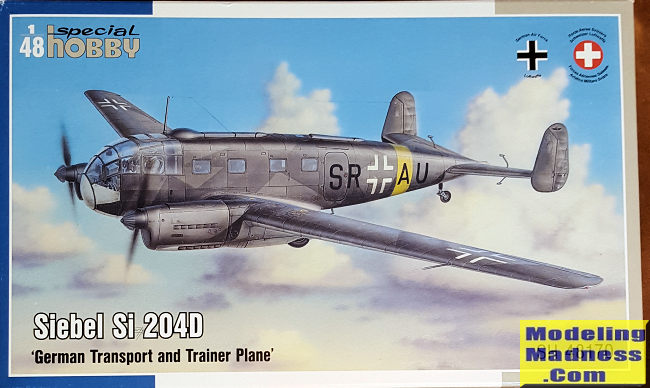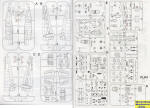
| KIT #: | SH48170 |
| PRICE: | $ 40.00 'used' |
| DECALS: | Three options |
| REVIEWER: | Scott Van Aken |
| NOTES: | 1995 release |

| HISTORY |
The Si 204 was planned as a small all-metal passenger aircraft with two crew and eight passengers for German airline Deutsche Luft Hansa (DLH). Development was initiated in 1938. The contractor was, as usual, the RLM, but the development was conducted in close collaboration between DLH and Siebel in Halle.
After the beginning of the war, the aircraft was redesigned as a trainer aircraft with a full "stepless" glass cockpit, as had been initiated with the He 111P in early 1938, with no separate flat windscreen for the pilot (much as almost all German bomber aircraft of the time were being designed), which seemed to be better for blind flying in the Si 204's case.
The first two prototypes only were delivered as passenger aircraft with the old cockpit. The maiden flight of the first prototype was before September 1940, possibly on 25 May 1940, that of the second prototype before February 1941. The third prototype was redesigned as a trainer aircraft for blind flying. As a result of this, the maiden flight was not earlier than the end of 1941 or the beginning of 1942.
At that time, Siebel produced the Junkers Ju 88 under licence, so only 15 prototypes were able to be built in Halle. As a result, Société Nationale de Constructions Aéronautiques du Nord (SNCAN) in France produced the A-0 preseries A-1 production passenger aircraft between April 1942 and November 1943.
Českomoravská Kolben-Daněk (ČKD, called Böhmisch-Mährische Maschinenfabrik AG [BMM] in German) in the Protectorate of Bohemia and Moravia delivered the first blind flying trainer D-0 in January 1943 followed by production of a further 44 D-0 preseries aircraft. The D-1 series was begun in March 1943 by Aero, also in the Protectorate, and by BMM in June or July 1943. In August 1943, SNCAN also delivered their first D-1.
Production of the D-3 was started in October 1944 by Aero Vodochody. The D-3 had wooden wings and a tail-plane made of wood and metal. French production of the D-1 was ended in August 1944 after the Liberation. SNCAN produced a total of 168 units of the Si 204. BMM produced the aircraft until October 1944 and then changed to producing spare parts for the Si 204. The Aero company was scheduled to cease production of the D-1 in March 1945 after building 486 aircraft and then switch to D-3 only. The aircraft, however, was only built until January 1945 with 541 completed.
Therefore, total production was 1,216 (until January 1945) including the prototypes; some production in other countries continued after the war ended. The type was operated post war by France, Czechoslovakia, and a few others.
| THE KIT |
 Though I've only built one model
of this aircraft, and that was the KP kit, I've always liked the design. I
thought the SH kit was rather pricey when it first came out so held off on
getting one. However, if one waits long enough, often one can get it at a
more reasonable price. So it was here.
Though I've only built one model
of this aircraft, and that was the KP kit, I've always liked the design. I
thought the SH kit was rather pricey when it first came out so held off on
getting one. However, if one waits long enough, often one can get it at a
more reasonable price. So it was here.
Special Hobby did several boxings of this and this is the Luftwaffe version. There are quite a few parts to this one as it is a trainer so you'll have to deal with a full cabin. In addition to a nicely equipped cockpit, the cabin area is set up as a radio/nav trainer. This means seats for four students and an instructor as well as the radio equipment and what looks like a rack for oxygen bottles.
If you want either of the cabin doors open, you'll have to cut them out, not a simple task. There is also some fuselage interior trimming that will need to be done. With the interior done, it is trapped between the fuselage halves after the windows have been inserted from the inside. The canopy pieces are added as well as the various bumps on the upper fuselage.
 Attention
is then turned to building up the main gear wells, gluing the wing halves
together and building up the engines. When doing the latter, the prop shaft
holes have to be drilled out. Wings are then installed along with the engine
nacelles. Tail pieces are then built and attached. With that done, the
landing gear and doors are built up and attached. Then the props are built.
These have separate blades to fit on a separate hub. The last parts are to
attach the doors if you cut out the areas on the fuselage for them.
Attention
is then turned to building up the main gear wells, gluing the wing halves
together and building up the engines. When doing the latter, the prop shaft
holes have to be drilled out. Wings are then installed along with the engine
nacelles. Tail pieces are then built and attached. With that done, the
landing gear and doors are built up and attached. Then the props are built.
These have separate blades to fit on a separate hub. The last parts are to
attach the doors if you cut out the areas on the fuselage for them.
Instructions are well done with Gunze paint references. There are markings for two different planes. Two of them are standard Luftwaffe types in RLM 70/71/65. A third option is for one of the previous planes in Swiss service. It is in RLM 70 over 65. The red bands on the tail and wings will need to be painted in place.
| CONCLUSIONS |
This will not be a quick and probably not a super easy build. Special Hobby kits have gotten really nice over the years, but they are still short run so must be treated as such. One thing for sure, with those long wings it will be a big model when done.
| REFERENCES |
Historical background from Wikipedia
November 2020
Copyright ModelingMadness.com. All rights reserved.
If you would like your product reviewed fairly and fairly quickly, please contact the editor or see other details in the Note to Contributors.
Back to the Main Page Back to the Review Index Page Back to the Previews Index Page